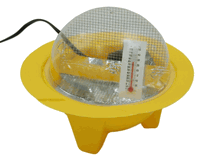General Information
The Chick Bator incubator has a clear dome, egg cradle, 110-volt light bulb assembly to produce heat, thermometer, and instructions. Use to hatch eggs that you can obtain locally or over the internet.
Chick Bator Capacity. Aprox. 3 chicken eggs,4 pheasant eggs, 2 turkey or duck eggs, 8 quail eggs. Operates on 110 volt electricity. 7" diameter, 6" high. Great for classroom projects.
This incubator requires egg turning 3 times a day, temperature monitoring and adjustment. Adult supervision is recommended to ensure hatching instructions are followed carefully. The successful hatching rate is typically around 50% when instructions are followed. Due to many variables beyond our control, successful hatching is not guaranteed.
Chick Bator Capacity. Aprox. 3 chicken eggs,4 pheasant eggs, 2 turkey or duck eggs, 8 quail eggs. Operates on 110 volt electricity. 7" diameter, 6" high. Great for classroom projects.
This incubator requires egg turning 3 times a day, temperature monitoring and adjustment. Adult supervision is recommended to ensure hatching instructions are followed carefully. The successful hatching rate is typically around 50% when instructions are followed. Due to many variables beyond our control, successful hatching is not guaranteed.

